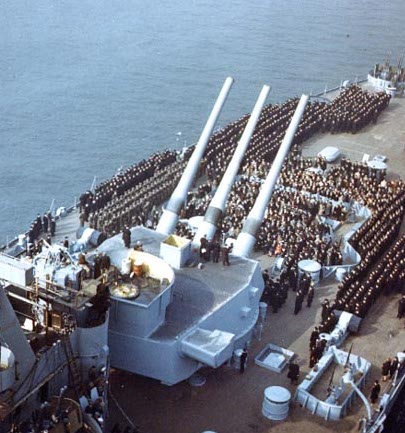![]() The Pacific War Online Encyclopedia
The Pacific War Online Encyclopedia
|
| Previous: U.S. 16"/45 Mark 6 Gun | Table of Contents | Next: U.S. 37mm Gun |

| Bore |
16" 406.4mm |
| Ammunition type |
Bagged APC and HC shells |
| Weight of round | 2700 lbs 1225 kg |
| Velocity | 2500 feet per second 762 meters per second |
| Maximum elevation
|
45 degrees |
| Range | 42,345 yards 38,720 meters |
| Firing cycle | 30 seconds |
| Loadout | 136 rounds per gun |
| Penetration |
26.2" at 10,000 yards 66.5 cm at 9100 m |
The 16"/50 Mark 7 was the main armament on the Iowas.
As such, it was the last battleship
gun ever fired in anger.
The Mark 7 was not originally part of the Iowa design. Although the use of 18" guns was seriously considered, the Navy settled on the 16"/50 Mark II gun, which had originally been designed for the capital ship classes canceled in conformance with the naval disarmament treaties. However, a miscommunication resulted in the Bureau of Ordinance designing turrets for barbettes with a diameter of 40' (12.19m) and the Bureau of Construction and Repair designing the hull with barbettes that were 39' (11.89m) in diameter. The discrepancy was discovered too late in the design process for the hull form to be modified to accommodate the larger barbette, and the Mark II could not be squeezed into a smaller turret. The Navy was forced to redesign the turrets to use a new and lighter gun design, which became the Mark 7. Fortunately, the Mark 7 proved to be an excellent weapon.
The guns were mounted in 3-gun turrets with individual slides allowing each gun to be elevated independently. Loading took place at a fixed elevation of 5 degrees, The guns were of built-up construction and could fire about 300 rounds before needing relining. The magazine capacities were 390 rounds for Turret I, 460 for Turret II, and 370 for Turret III. Thus the average rounds per gun was 136 rounds, or a little over a third of the gun lifetime.
The Mark 7 was provided with two basic rounds. The APC round was the Mark 8 "super-heavy" round, which weighed 2700 lbs (12256 kg). The use of such a heavy round reduced bore wear while increasing penetration, particularly of deck armor by plunging fire at likely battle ranges. This came at the cost of reducing the maximum range by 4500 yards (4100 m) compared to a more conventional 2240 lb (1016 kg) round. The explosive charge was 70 lbs (32 kg) of dunnite and the fuse detonated the charge 0.033 seconds after the shell encountered resistance equivalent to 1.5" (38mm) of armor plate. The HC round was the Mark 13, which weighed 1900 lbs (862 kg) and carried a relatively large explosive charge of 154 lbs (70 kg) of dunnite. This shell could be fused either for instantaneous detonation or 0.15 second delay. Both shells could be fired with reduced propellant loads to further reduce barrel wear and give the projectiles a steeper angle of fall.
The propellant was SPD (diphenylamine-stabilized nitrocellulose) in the form of grains 2" (50mm) long and 1" (25 cm) in diameter with seven perforations. The grains were loaded into silk bags weighing 110 lbs (50 kg) each, and six bags made up a full propellant charge. Each bag was fitted with an ignition pad at one end containing a small charge of black powder.
The claim that the guns proved difficult to align properly,
and accuracy suffered until this problem was rectified following the
battle of Leyte Gulf, is apparently an urban legend, On the contrary, the Mark 7 was possibly the finest battleship gun ever deployed.
References
Navweaps.org (accessed 2015-3-23)
The Pacific War Online Encyclopedia © 2007, 2009, 2015 by Kent G. Budge. Index